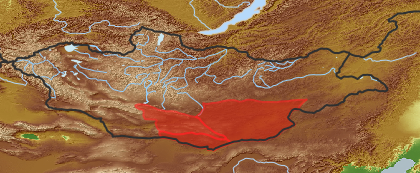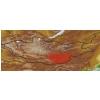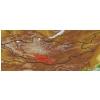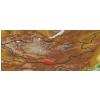| Class: | angiosperms |
| Order: | Rosales |
| Family: | Rosaceae |
| Genus: | Amygdalus |
| Scientific name: | Amygdalus mongolica (Maxim.) Ricker |
| Name acc. to: | Gubanov 1996 |
| Herbar: | list records   |
| Description: | Small shrub 25-80 cm high, very thorny. Leaves 0.5-1.5 cm long, oval, finely serrate-dentate, glabrous, coriaceous. Flowers pink, expanding before leaves. Fruits subsessile, dry. |
| Link to Flora of China: | http://www.efloras.org/browse.aspx?flora_id=2&name_str=Amygdalus+mongolica |
| open map in a new window |  |
| Habit (i)general appearance of a plant | |
| Growth form: (i)Herb, shrub, tree or climber. | herb (i)Herbaceous, erect plant, up to 2m high, mostly with a leafy shoot; if perennial, shoots die to the ground each season, shoots are not woody
example: Artemisia pectinata   inherited by genus Amygdalus: herb inherited by genus Amygdalus: herb
perennial (i)Living for several to many years, as opposed to annual and biennial  inherited by genus Amygdalus: perennial inherited by genus Amygdalus: perennial
shrub, subshrub or semishrub (i)Shrub, multi-stemmed, mostly (0.2) 0.5 - 5 m high, shoots woody up to the tip
example: Caragana leucophloea 
tree (i)Woody plant with a clear main trunk, at least 2-3 m tall
example: Ulmus pumila   inherited by genus Amygdalus: tree inherited by genus Amygdalus: tree
|
| Parasite status: (i)Is the plant a half- or full parasite? | no parasite/saprophyte (i)Plant fully autonomous, leaves with chlorophyll
example: Most plants, Ranunculus  inherited by family Rosaceae: no parasite/saprophyte inherited by family Rosaceae: no parasite/saprophyte
|
| Leaf (i)expanded, usually photosynthetic organ of a plant (including phylloclades) | |
| Leaf development: (i)Structure and development of leaves. | with green leaves (i)Plant with green leaves  inherited by family Rosaceae: with green leaves inherited by family Rosaceae: with green leaves
|
| Leaf arrangement: (i)Arrangement of leaves at the stem. | opposite, opposite-decussate (i)Two leaves per node
example: Lamiaceae, e.g. Phlomis    inherited by genus Amygdalus: opposite, opposite-decussate inherited by genus Amygdalus: opposite, opposite-decussate
basal rosette (i)Leaves positioned at the base of the stem; stem often without leaves, no visible internodes (but flowers often on erect stems, and these may have few leaves)
example: Limonium, Potentilla, Plantago; also used in Liliales with basaly crouwded leaves (Tofieldia, Zigadenus etc.)   inherited by genus Amygdalus: basal rosette inherited by genus Amygdalus: basal rosette
|
| Stipule: (i)Leaflets at the base of the petiole, these are smaller and of different shape. | pair (i)A pair of free stipulae
example: Lathyrus, Trifolium   inherited by genus Amygdalus: pair inherited by genus Amygdalus: pair
|
| Flower (i)reproductive portion of the plant, consisting of sepals, petals, stamens, and pistils | |
| Flower appearance and pollination: (i)General appearance of the flower. | attractive, animal-pollinated (i)attractive and coloured flowers, mostly large, attracting surely animals
example: Trollius, Rosa, Chamaerhodos  inherited by family Rosaceae: attractive, animal-pollinated inherited by family Rosaceae: attractive, animal-pollinated
|
| Perianth arrangement: (i)Attention: in some plants, flowers may be dimorphic in different ways (dioecious or gynodioecious). If flowers vary, record the characters of the most showy flowers. | double, different (i)Two types of perianth leaves, differently coloured (sepals: outer periant leaves, usually greenish, and petals: inner perianth leaves, usually coloured)
example: Parnassia    inherited by genus Amygdalus: double, different inherited by genus Amygdalus: double, different
|
| Flower symmetry: (i)Symmetry of the perianth leaves. Attention: to assess this character, look on sepals, petals and stamens, but neglect carpels and ovary. | radiary, regular (actinomorphic) (i)More than two axis of symmetry
example: Saxifraga: 5; Iris: 3   inherited by family Rosaceae: radiary, regular (actinomorphic) inherited by family Rosaceae: radiary, regular (actinomorphic)
|
| Flower form: (i)common forms of flowers ? Veronica | simple (flat) - Do not confuse with inflorescences as in some Asteraceae (i)Petals spread out, flower appearing flat
example: Mollugo, Trientalis, Pulsatilla, Saxifraga   inherited by family Rosaceae: simple (flat) - Do not confuse with inflorescences as in some Asteraceae inherited by family Rosaceae: simple (flat) - Do not confuse with inflorescences as in some Asteraceae
|
| Sepal number: (i)Number of sepal leaves (outer perianth leaves, calyx leaves, mostly greenish). Attention, this character applies only for flowers separated in sepals and petals, thus excluding most monocots. Be aware of the bracts (involucral leaves) of Asteraceae flowerheads, do not qualify these as sepals! Be also aware in Rosaceae is often an epicalyx developed, in this case count all parts. | 5 (i)
example: Polemonium  inherited by genus Amygdalus: 5 inherited by genus Amygdalus: 5
|
| Petal / Tepal number: (i)Number of petal leaves (inner perianth leaves, usually coloured). | 5 (i)
example: Potentilla  inherited by genus Amygdalus: 5 inherited by genus Amygdalus: 5
|
| Petal / Tepal fusion: (i)To which degree are the petal leaves connected? Petals sympetalous. | free (i)all petal leaves separate from each other
example: Anthriscus  inherited by family Rosaceae: free inherited by family Rosaceae: free  inherited by genus Amygdalus: free inherited by genus Amygdalus: free
|
| Spur: (i)A hollow, slender, sac-like appendage of the perianth leaves, storing nectar. | no spur (i)Flower without appendage
example: Peganum  inherited by family Rosaceae: no spur inherited by family Rosaceae: no spur
|
| Stamen fusion: (i)To which degree are the stamens fused? Attention: Whereas the pollen sacs itself are often free., their stalks (filaments) may be fused. Here, we count them as fused if they are together over at least one thirth of their length. | free (i)Stamens with separate bases
example: Malus  inherited by family Rosaceae: free inherited by family Rosaceae: free
|
| Inflorescence (i)flowering part of a plant, describes the arrangement of the flowers on the flowering axis | |
| Inflorescence: (i)Structure of the inflorescence. | Solitary flowers (i)Each flower grows on an own leafy stem there may be more than one, if the plant has many leafy shoots
example: Viola, Saxifraga hirculus, Rubus arcticus  inherited by genus Amygdalus: Solitary flowers inherited by genus Amygdalus: Solitary flowers
|
| Fruit (i)the seed bearing organ, with or without adnate parts; a ripened ovary and any other structures which are attached and ripen with it. Aggregate fruits are handled like simple fruits for determination. | |
| Consistency: (i)Fleshy fruits or dry fruits, see dispersal adaptations for further classification. | fleshy (i)Usually non dehiscent; with a fleshy (swollen because of a high water content) outer shell, flesh edible at least for animals
example: Prunus, Amygdalus, Malus  inherited by genus Amygdalus: fleshy inherited by genus Amygdalus: fleshy
|
| Type of fruit: (i)Common fruit types (including pseudocarp). | Indehiscent fruits  inherited by genus Amygdalus: Indehiscent fruits inherited by genus Amygdalus: Indehiscent fruits
Solitary fruits (i)     inherited by genus Amygdalus: Solitary fruits inherited by genus Amygdalus: Solitary fruits
achene (i)A small, dry, indehiscent fruit with a single seed
example: Asteraceae, Apiaceae (schizocarp), Dipsacaceae, Rosaceae, Ranunculaceae    inherited by genus Amygdalus: achene inherited by genus Amygdalus: achene
berry (i)Fleshy fruit with several to many seeds in the flesh
example: Tomato   inherited by genus Amygdalus: berry inherited by genus Amygdalus: berry
nut or nutlet (i)Dry fruit with a single, hard stone inside (and usually a large often edible embryo)   inherited by genus Amygdalus: nut or nutlet inherited by genus Amygdalus: nut or nutlet
drupe (stone fruit) (i)Fleshy, indehiscent fruit with a single, hard stone inside
example: Plum, cherry   inherited by genus Amygdalus: drupe (stone fruit) inherited by genus Amygdalus: drupe (stone fruit)
|
| Dispersal: (i)Appearance of fruit or seed (if single) and adaptations to dispersal. | Fleshy, edible (i)At least parts with a soft tissue edible at least for some animals (not necessarily for humans)  inherited by genus Amygdalus: Fleshy, edible inherited by genus Amygdalus: Fleshy, edible
Flying (wind dispersed) (i)Fruits or seeds with appendages to fly
example: Taraxacum, Atraphaxis, Pulsatilla  inherited by genus Amygdalus: Flying (wind dispersed) inherited by genus Amygdalus: Flying (wind dispersed)
Otherwise (i)All parts dry, no conspicuous adaptations  inherited by genus Amygdalus: Otherwise inherited by genus Amygdalus: Otherwise
|
| Root / shoot below ground (i)plant part below ground (in most cases), including below ground shoots, without leaves | |
| Root type: (i)Organisation of the roots. | allorhizous (i)Plant with a conspicuous tap root, one larger tap root with side roots
example: Dicotyledonae  inherited by order Rosales: allorhizous inherited by order Rosales: allorhizous
|
| Distribution (i)region where the plant is likely to be found | |
| Distribution (Veg. Zones): (i)acc. to Grubov 1952 | East Gobi (i)In distribution data often named as '12' 
Gobi-Altai (i)In distribution data often named as '13' 
Alashan Gobi (i)In distribution data often named as '16' 
acc. to: Gubanov 1996 |
| Plant Status | |
| Endemism: | subendemit: East Mongolia within Outer Mongolia
acc. to: Gubanov 1996 |
| Red list status: (i)Rare Mongolian plants | rare (Shiirevdamba 2007) (i)Rare plant
|